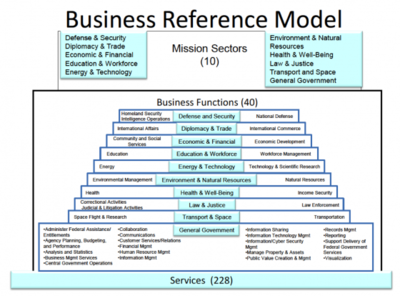Business Reference Model (BRM)
The Business Reference Model (BRM) is a graphical, hierarchical representation of the federal government day-to-day business operations and activities. The BRM represents the first layer of the Federal Enterprise Architecture Framework, which presents the business using a functionally driven approach.[1]
Business Reference Model (BRM) History [2]
One of the first business reference models ever defined was the "IMPPACT Business Reference Model" around 1990, which was the result of a research project in the Computer Integrated Manufacturing (CIM) field of the ESPRIT1 programme. Gielingh et al. (1933) described: The IMPPACT Business Reference Model is expressed in the generic language constructs provided by IDEF0... It describes the requirements for CIM seen from a business point of view. Views modelled are manufacturing activities, real and information flow objects resource objects (information and material processing components) and organisational aspects (departments and their relations to activities and resources). The complete manufacturing system (including the production system and its management) is modelled by the IMPPACT Business Reference Model. Management covers both the planning of the production and the planning and control of this production. The term IMPPACT stood for Integrated Manufacturing of Products and Processes using Advanced Computer Technologies Furthermore, in its framework were incorporated CIMOSA as reference model, NIAM for information modelling, and the data modeling language EXPRESS for information structure implementation.
In the 1990s, business reference models were hardly an item. An exception was a 1991 book about IT management, which mentioned that the Kodak management had developed a business reference model 10 years earlier. A 1996 manual of the SAP R/3 enterprise resource planning software stipulated the existence on the business reference model of the R/3 System. However, in the 1990s there was a significant development of reference models in related fields, which, resulted in the developments of Integrated business planning, the Open System Environment Reference Model, the Workflow Reference Model, TOGAF and the Zachman Framework.
In the new millennium business reference models started emerging in several fields from network management systems, and E-business, to the US Federal government. The US Federal government published it's "Business Reference Model", Version 1.0 in February 2002. Related developments in this decade were the development of the Treasury Enterprise Architecture Framework, and the OASIS SOA Reference Model.
The Purpose of the Business Reference Model[3]
The purpose of the BRM is to define and communicate, for all interested stakeholders, a high-level view of how – in business terms – the Federal government achieves its various missions. It enables users to identify how processes are being supported, where they are being supported, where there are opportunities to reduce redundancies, and how to build more cost-effective solutions in the future.
The Business Reference Model (BRM) describes an organization through a taxonomy of common mission and support service areas instead of through a stove-piped organizational view, thereby promoting intra- and inter-agency collaboration. [4]

source: EA Pad
Value and Benefits of Business Reference Model (BRM)[5]
The BRM is the first layer of the National Enterprise Architecture. It is the main viewpoint for the analysis of data, applications and their capabilities, and the implementation of technologies to support reuse and standards. This framework should be used by Agencies when identifying and building E-Gov architectures to ensure that investments leverage existing components, applications, and services across the National Government.
One of the primary benefit of enterprise architecture is to support and improve organization-wide strategic planning and decision-making. The BRM is designed to provide agencies with a standard means to categorize their capital investments, identify areas for collaboration, consolidation and reuse based on the business functionality being delivered, and help improve the overall [IT architecture to better enable mission outcomes. The BRM also provides decision-support capabilities to stakeholders and different levels of staff, within and between agencies. The Business Reference Model (BRM) forms a key part in delivering expected outcomes and business value to an organization. By using a standard taxonomy to classify functions, investments, programs, services and other elements across the national Government, the BRM is useful in identifying opportunities for cost reduction, collaboration, shared services, and solution reuse in agency IT portfolios and intra- and inter-agency collaboration.
While the BRM provides a standardized way of classifying government functions, it is only a model; its true utility and value is realized when it is applied and effectively used in business analysis, design and decision support that help to improve the performance of an agency, or program.
Other Benefits:
- enables identification of commonly used functions across government agencies and hence lead to identification of sharable data, application and infrastructure components.
- Helps identify and prevent redundancies or gaps in business operations and systems; this could drive down costs by an order of magnitude.
- Improves communication and understanding between government operations and information technology.
- Helps answer the question “Why do we need this Application and Data technology?”
See Also
References
